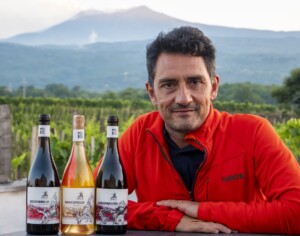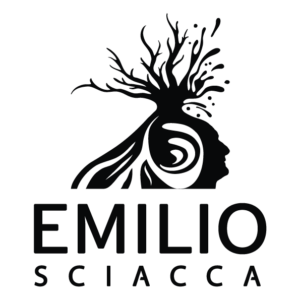Emilio Sciacca

Emilio Sciacca
About
Owner: Emilio Sciacca
Winemakers: Emilio Sciacca and Emanuele Poli
Vineyards: 2.5ha of estate vineyards, and 1.2ha of leased vineyards
Vineyard management: Sustainable, in organic conversion. Only sulfur and copper treatments, no irrigation.
Soils: Varied volcanic soils created by lava flows, predominantly sandy
Grapes grown: Nerello Mascalese, Nerello Cappuccio, Carricante, Cataratto, Grecanico Dorato, Grillo
Annual production: 15,000 bottles
Quick facts:
- The goal of the Emilio Sciacca project is to make natural wine that expresses the unique terroir of Etna in a way that’s accessible to all wine drinkers, from novice to expert.
- Making wines on an active volcano can be a double-edged sword: there are fascinatingly diverse soils created by lava flows from different eras, but you sometimes have to contend with volcanic ash emissions falling directly on the vineyards.
- The hard-working gnomes on the labels, besides being caricatures of Emilio and Emanuele, represent the microorganisms who they consider “the real protagonists of the enological miracle.” “With our labels we’re trying to thank them, knowing that no matter how much knowledge we have and no matter how much work we do, they’re always the ones who transform our grapes into a ‘magical’ beverage,” Emilio explains.
The wines of Emilio Sciacca are best described as a love letter to the terroir of Etna. Emilio Sciacca was working in nature tourism on the volcano in 2008 when he fell in love with rugged and extraordinary terrain. He was inspired by the idea of offering the many tourists who came to the area from all over the world the opportunity to eat and drink the very best products of the region. In 2016, Emilio had the opportunity to purchase a parcel of land in Linguaglossa, on the northern side of the volcano, with breathtaking views of Etna’s often-smoking summit. Since then, they’ve had the opportunity to expand to a select few other parcels: they now own 2.5ha of vineyards and farm another 1.2 ha of leased vineyards. “The first harvest was in 2018 and from then we have continued to work to improve each year within the limits of what nature gives us,” Emilio tells us.
Thanks to the extreme natural geography of Mt. Etna, Europe’s largest active volcano, vineyards can be found in a wide range of different microclimates: from 400m up to 1300m elevation; with north, south, or east exposures; and volcanic soils formed from lava flows during various time periods with many different chemical compositions. “We have vineyards in areas that are different enough that they produce grapes which make very different base wines, which sometimes we blend and sometimes we vinify separately,” Emilio explains. The fertile soils mean that olive trees, pistachio trees, and fruit trees can be found planted between the vineyards, unlike in many other famous viticultural areas where a monoculture of grapevines extends for miles.
While beautiful and fascinating, Etna is not always an easy place to make wine. With such a southerly latitude and high altitude, the vines can face scorching daytime temperatures and surprisingly cold nights, as well as drought, frequent storms, and hail. There’s also the rather more unusual threat of volcanic ash emissions falling directly on the vineyards. Furthermore, the vineyards are traditionally planted in the albarello style (high density, no wires, one wooden stake per vine) on narrow dry stone terraces, which makes mechanization impossible.
All in all, these unusual characteristics are what make wines from Etna so special and distinctive. Emilio aims to express these qualities in the wines as purely as possible, without faults, “extreme” flavors, or “cosmetics.” “We want to accompany the enological process, using the scientific knowledge that we’ve acquired, but without ever forcing it with the use of synthetic chemicals,” Emilio explains. Grapes are carefully destemmed in a manner that preserves each berry as whole as possible, followed by a pre-fermentation maceration for the whites, or maceration during fermentation for the reds. “At the moment, most of our containers for fermenting and aging are stainless steel with a few portions aged in amphora. In the future we’re thinking about moving to cement (not glass-lined),” he tells us. No additions of any kind, including sulfur, are used during vinification and aging. Only at bottling do some wines (but not all) receive a small sulfur addition around 30 mg/L.

